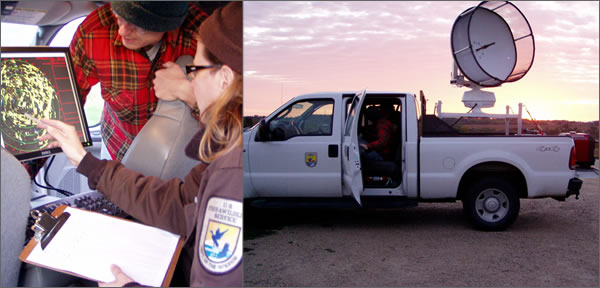Upper Midwest Environmental Sciences Center
Evaluating the Possible Effects of Wind Power Development on Refuging Waterbirds in the Great Plains, Upper Midwest and East Front of Northern Rocky Mountains
We will address the question of whether wind farms can be built near refuges for large concentrations of waterbirds and not cause mortality or critical habitat avoidance. Much is known about many waterbirds (waterfowl, cranes, shorebirds and others) and the places where they concentrate (refuge) during migration. The primary areas of uncertainty in placing wind turbines in relation to the location of these concentration areas include understanding how birds will respond to wind farms, what features of the landscape influence this response, and -- if there is a response – determining if it is energetically costly or presents a significant threat, potentially death, to birds. This line of research and development will result in formulation of a three-dimensional model that predicts probalistic movements of birds across target landscapes and will form the underlying model for a decision support system (DSS) applicable in the Great Plains, Prairie Potholes, Northern Rockies, and Midwestern landscapes, as a starting point. A major challenge in this research will be examining bird movements aloft during inclement weather, when birds are most at risk of collision with turbines in low visibility, and when sensitivity of radar data is limited because of precipitation interference. The goals of the five year project include:
Years 1-2
- Fully develop three-dimensional movement model for Sandhill Cranes in the Horicon landscape.
- Begin model development for Whooping Cranes and geese.
- Determine if NEXRAD can be used to evaluate pre- and post- construction bird movements and intensities in appropriate areas.
- If NEXRAD can be used to evaluate pre- and post-construction bird movements, employ artificial intelligence (AI) algorithms recently developed by NOROCK and collaborators to undertake these retrospective analyses.
Years 3-5
- Validate and update model functionality by investigating other refuging areas in the Great Plains and Midwest.
- Use vertical profiler radar to refine three-dimensional data on bird flight paths.
- Technique development for evaluating bird movements aloft during inclement weather.
- Apply the model to other wind energy developments identified with our collaborators, and use the marine radar equipment and field techniques to iteratively validate the model and test hypotheses regarding the effects of wind energy development.

http://www.nrmsc.usgs.gov/science/wind/migration_elevation
For more information contact:
Eileen Kirsch
USGS-UMESC
608-781-6226
ekirsch@usgs.gov
Page Contact Information: Contacting the Upper Midwest Environmental Sciences Center
Page Last Modified: February 1, 2016



